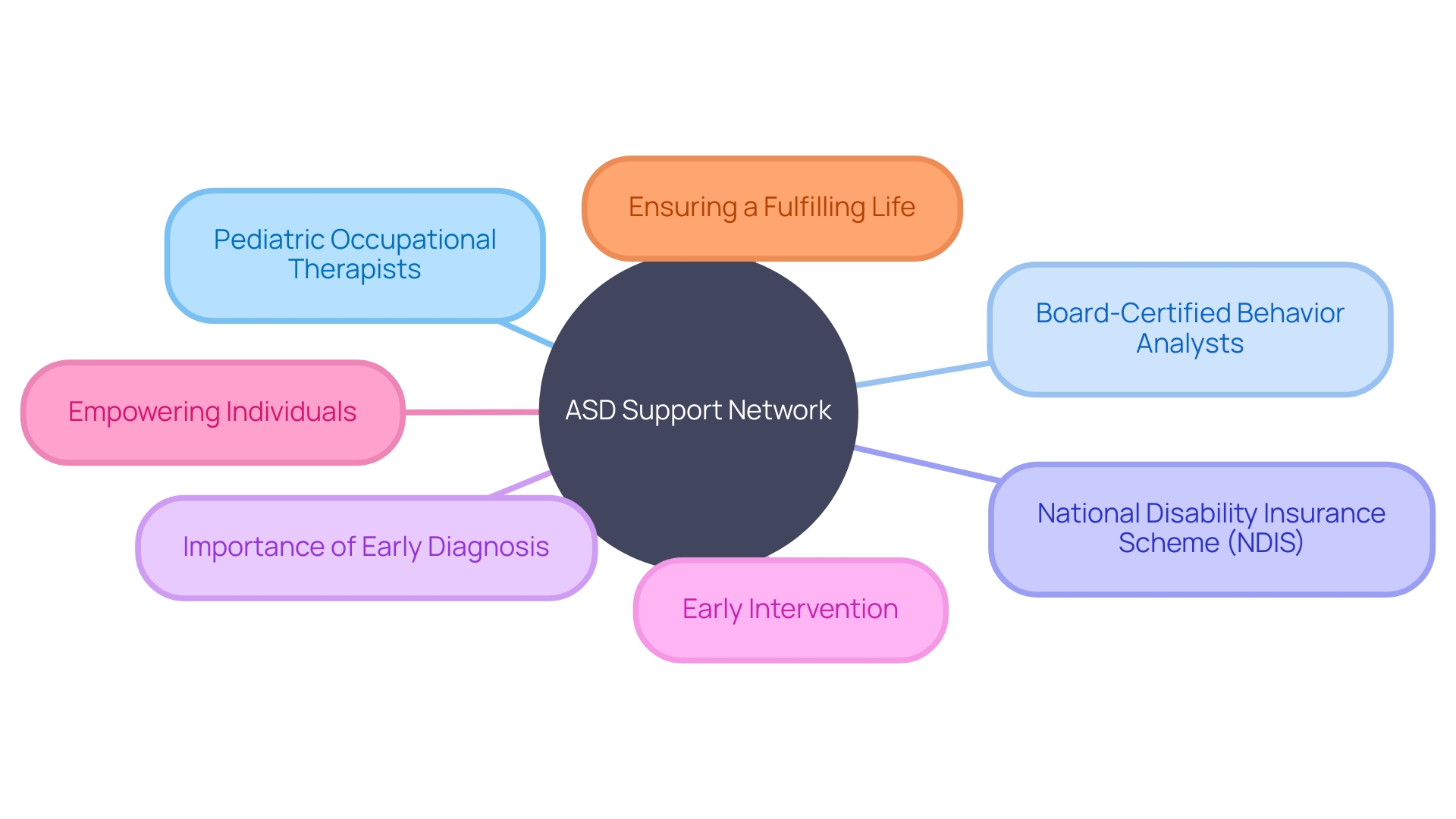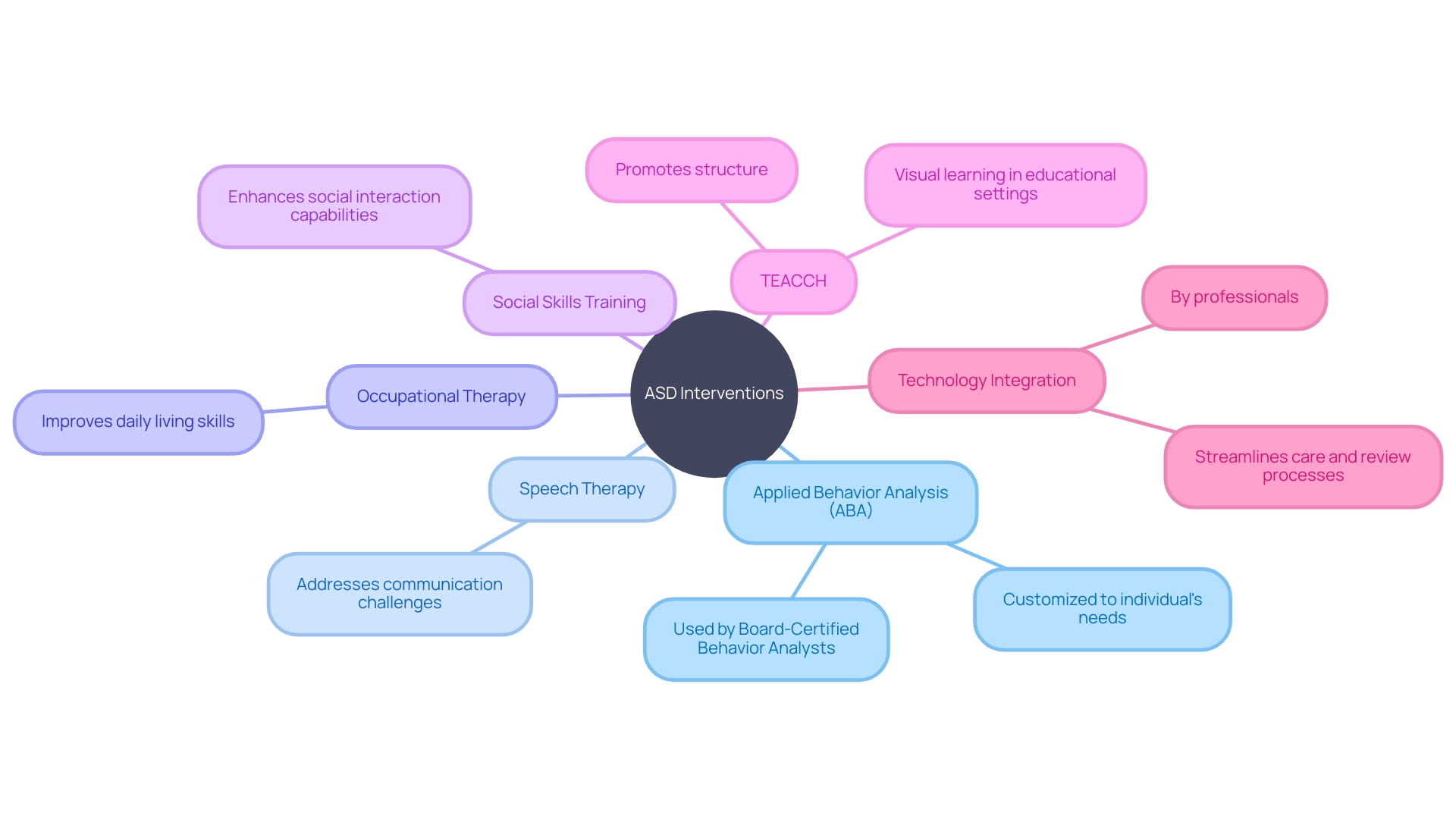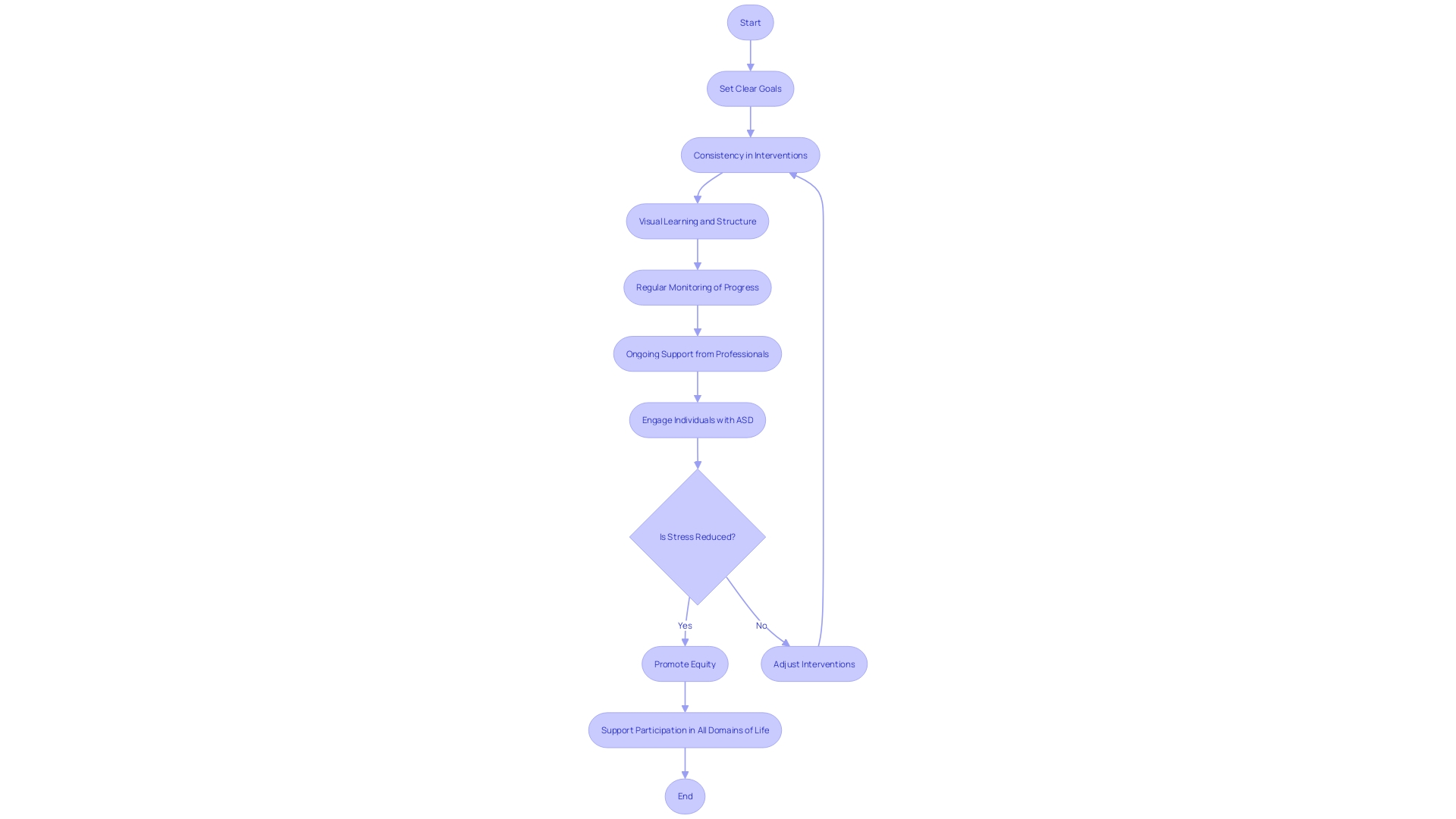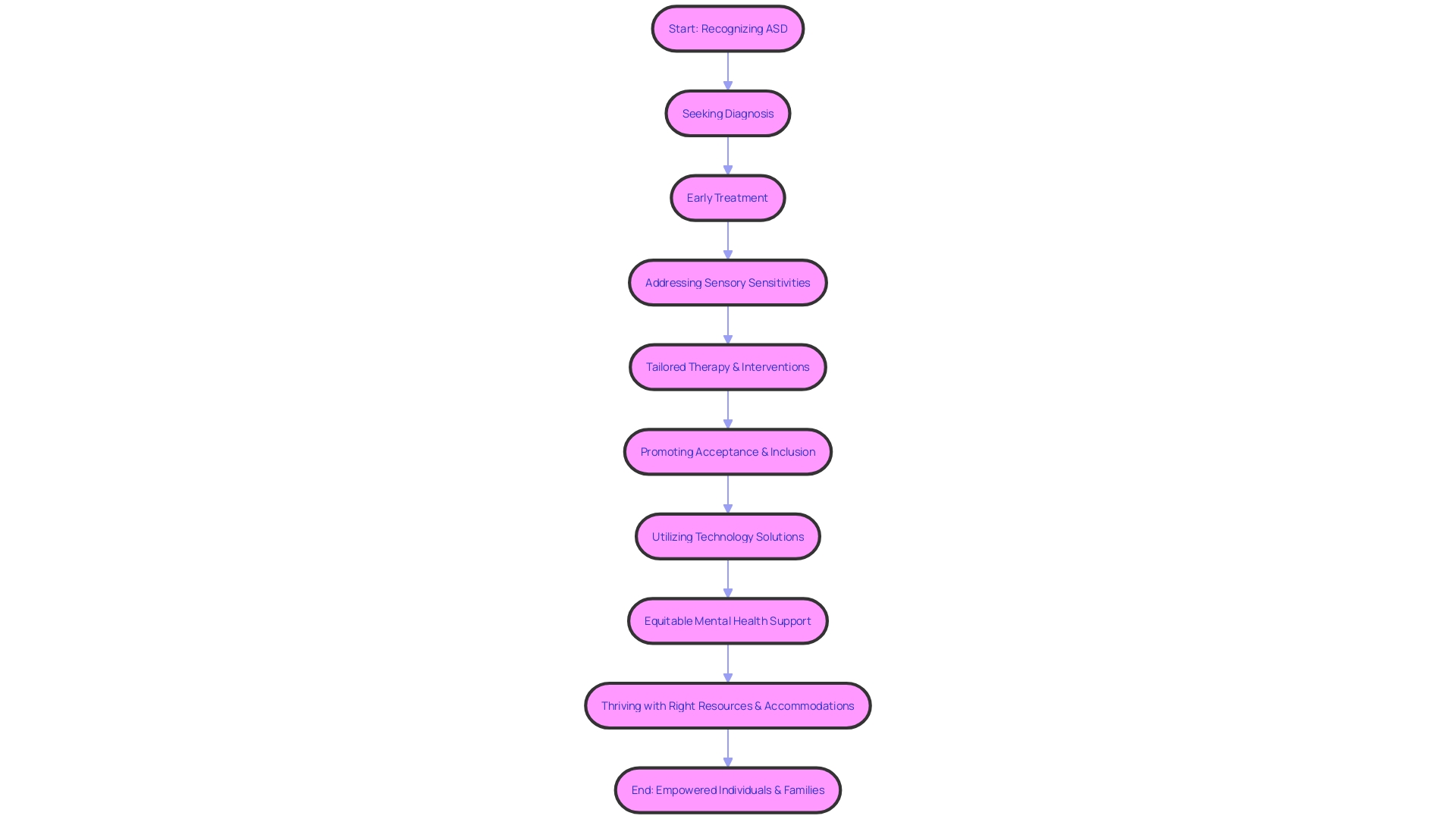Introduction
Autism Spectrum Disorder (ASD) presents unique challenges in social interaction, communication, and behavior. However, with targeted therapy and support, individuals with ASD can thrive in daily life. Pediatric occupational therapists like Kara from Florida play a vital role in empowering children with autism to navigate these challenges and foster independence.
Board-Certified Behavior Analysts also contribute to this journey by specializing in technology solutions that enhance coordinated care. Together, these professionals advocate for personalized care and support for individuals with ASD, ensuring that they are not dismissed in therapeutic settings. Initiatives around the world, such as Australia's National Disability Insurance Scheme (NDIS), further emphasize the importance of early intervention and personalized support plans.
As awareness grows, the understanding that early diagnosis and intervention are crucial continues to evolve. The collective efforts of therapists, behavior analysts, and support systems exemplify a dedicated network striving to provide every individual with ASD the tools and opportunities to lead fulfilling lives.
Understanding Autism Spectrum Disorder (ASD) and the Need for Therapy
Autism Spectrum Disorder (ASD) is characterized by unique challenges in social interaction, communication, and behavior. Yet, with targeted therapy and support, individuals with ASD can learn to navigate these challenges, unlocking their potential to thrive in daily life. Pediatric occupational therapists like Kara from Florida play a vital role in this developmental journey.
Through Independence Therapy, they empower children with autism to perform daily tasks autonomously, fostering self-reliance and growth. Kara's approach has led to notable successes, such as with an 11-year-old girl who, despite her anxiety and higher support needs, made significant strides in her independence. This personal touch in therapy is echoed by Board-Certified Behavior Analysts who specialize in technology solutions that enhance coordinated care.
With an understanding of psychological and societal challenges, these professionals offer a beacon of hope for autistic individuals, especially upon reaching adulthood. They champion the need for personalized care, advocating against the dismissal of autistic adults in therapeutic settings. The initiatives in Australia further illuminate the global effort to support those with ASD.
The National Disability Insurance Scheme (NDIS) exemplifies a commitment to personalized support plans, while early intervention programs concentrate on key developmental areas. As awareness grows, so does the understanding that early diagnosis and intervention are crucial. Ultimately, the collective efforts of therapists, behavior analysts, and support systems exemplify a dedicated network striving to ensure that every individual with ASD is provided with the tools and opportunities to lead a fulfilling life.

Types of Interventions for ASD
Autism Spectrum Disorder (ASD) presents a range of challenges that can vary greatly from person to person. Addressing these needs requires a multifaceted approach, employing various interventions tailored to each individual's unique situation. Among the most recognized interventions is Applied Behavior Analysis (ABA), a therapy that uses reinforcement strategies to encourage positive behaviors and skills.
Speech therapy is also pivotal for enhancing communication abilities, while occupational therapy focuses on improving daily living skills and fostering independence. Additionally, social skills training is crucial for individuals with ASD to navigate social interactions more effectively. It is essential to understand that these interventions are not one-size-fits-all; they must be customized and adjusted to align with each person's developmental level and learning style.
Clinicians and researchers are constantly refining these interventions, drawing from the latest studies, including randomized controlled trials, to ensure their effectiveness. The Treatment and Education of Autistic and Related Communication-Handicapped Children (TEACCH) approach exemplifies this, promoting structure and visual learning to aid teachers in creating supportive educational environments. The impact of these interventions on mental health and equity in society is profound, as evidenced by the words of Dr. David (Dan) R. Offord, who highlighted the importance of fair and supportive conditions for children with disabilities.
Furthermore, the integration of technology in care management by professionals like Board-Certified Behavior Analysts underscores the commitment to high-quality, coordinated care. The collective goal is a harmonious system that addresses the full spectrum of needs and potential risks, ensuring that interventions not only meet immediate goals but also contribute to lasting, positive changes in the lives of individuals with ASD and their families.

Evidence-Based Practices (EBPs) for ASD
Choosing an effective treatment for individuals with Autism Spectrum Disorder (ASD) is paramount to fostering their healthy development and ensuring they can participate in all aspects of life. Evidence-Based Practices (EBPs) are central to this goal as they are grounded in scientific research and have demonstrated positive outcomes. Notable EBPs such as Early Intensive Behavioral Intervention (EIBI), Pivotal Response Treatment (PRT), and Picture Exchange Communication System (PECS) have shown effectiveness in addressing the core challenges associated with autism.
These challenges include difficulties with social communication and repetitive behaviors, which can impact a child's ability to engage in school, home, and leisure activities. Research highlights the importance of selecting interventions with a solid evidence base to not only meet the individual needs of children with autism but also to support the well-being of families and caregivers. The integrity of research methodologies, such as randomized controlled trials, has progressively become a focus in the autism community, ensuring that the interventions recommended are both respectful and effective.
With the clinical study landscape evolving rapidly, the number of studies has soared from 2,119 in 2000 to around 454,000 by May of 2023, indicating a substantial increase in scientific inquiry. This surge underscores the critical need for caregivers to choose EBPs that are scientifically proven to support their child's unique journey and contribute positively to their mental health and societal equity.
Key Components of Effective ASD Interventions
Effective interventions for Autism Spectrum Disorder (ASD) are multi-faceted and require a holistic approach that goes beyond the application of standardized treatments. Tailored to the individual's unique profile, these interventions must evolve with ongoing assessments and adjustments. The diligence of trained professionals is crucial in implementing these strategies consistently.
Moreover, the collaborative efforts of parents, educators, and therapists are vital in creating a supportive network that addresses the complexities of ASD. Research underscores the importance of such rigorous methodologies, highlighting that interventions void of such structured and collaborative approaches often fail to accurately measure their effectiveness and potential unintended effects. These findings urge a reevaluation of traditional intervention research and call for a focus on interventions that can genuinely make a meaningful difference in the lives of those with ASD.
With the prevalence of autism as high as 1 in 36 individuals, according to the CDC, the stakes are high to ensure that interventions are not only effective but also fair, equitable, and supportive of the mental health and well-being of individuals with ASD and their families.
Individualized and Developmentally Appropriate Interventions
Recognizing the unique strengths and challenges of each individual with Autism Spectrum Disorder (ASD) is crucial when it comes to interventions. Just as Kara, a pediatric occupational therapist from Florida, emphasizes the importance of independence and tailoring activities to support the capabilities of autistic children, so too must interventions be personalized to address the diverse needs and developmental stages of those with ASD. A one-size-fits-all approach does not suffice, as evidenced by the varied experiences of autistic individuals like Lil from Southampton, UK, who benefited from transitioning to a community-based setting that offered structured activities aligned with her interests and developmental level.
In line with the recommendations of the Interagency Autism Coordinating Committee (IACC), interventions should be evidence-based, reducing bias and ensuring social validation. They should also consider the individual's right to autonomy, as highlighted in the terms and concepts related to decision-making for people with disabilities. The pursuit of equitable participation in all life domains, a principle echoed by the late Dr. David (Dan) R. Offord, is integral to fostering mental health and ensuring that every individual with ASD has the opportunity to thrive in a supportive environment.
With an estimated 1 in 36 individuals affected by ASD, as per the CDC, it is imperative that tailored interventions accommodate the full spectrum of autism and its manifestations in communication, social interaction, and behavior.
Importance of Collaboration Between Parents and Educators
The synergy between parents and educators plays a pivotal role in framing successful strategies for individuals with Autism Spectrum Disorder (ASD). Parents, who are attuned to their child's unique strengths, preferences, and challenges, bring an indispensable perspective to the table. On the other hand, educators come equipped with specialized skills in crafting and administering interventions conducive to learning environments.
Through a collaborative effort that embraces mutual competence, as highlighted by the National Center for Systemic Improvement, both parties can concoct tailored intervention strategies that foster a child’s growth not just academically, but also socially and emotionally across diverse settings such as home, school, and the wider community.
This partnership is the keystone of creating equitable opportunities for children with disabilities—a sentiment echoed by the late Dr. David (Dan) R. Offord who emphasized the importance of a fair 'race' for all children. It is about understanding and addressing the unmet needs of autistic children, acknowledging the assets they contribute to their communities, and minimizing chronic stressors. Moreover, current research methodologies, including randomized-controlled trials, underscore the importance of evidence-based practices and social validation in autism interventions to ensure they lead to meaningful and lasting change.
The profound impact of these joint efforts is not only felt by the children but also by the caregivers, who are empowered with the necessary resources to support healthy development and family well-being, thus making the race fair, as Dr. Offord envisioned.
Challenges in Implementing ASD Interventions
Navigating the complexities surrounding Autism Spectrum Disorder (ASD) interventions is a multifaceted endeavor. Parents and caregivers often find themselves contending with a dearth of accessible therapy services, which is a formidable barrier to obtaining the necessary support. Financial hurdles further complicate the situation, as do the scarcities of adequately trained professionals adept at delivering suitable interventions tailored to the unique requirements of each individual.
To surmount these challenges, a proactive approach is paramount, involving the identification and utilization of available resources to facilitate the essential interventions that foster the welfare and enrich the lives of those with ASD.
Notably, the success of interventions hinges on the implementation of evidence-based practices and the robust design of study methodologies, which can mitigate risks of bias and yield lasting, meaningful change. This is underscored by the sentiment that equitable participation in society's fundamental domains—school, home, and leisure—is critical for mental health and well-being, particularly for children and youth with disabilities. It is through recognizing their unmet needs and the strengths they contribute to their communities that we can alleviate chronic stress and empower caregivers with the resources necessary to nurture healthy development.
The pursuit of open science methodologies, as highlighted during the pandemic's research collaboration successes, exemplifies the positive outcomes that can arise from transparent and shared scientific endeavors. Similarly, in the context of ASD, open science can play a pivotal role in advancing understanding and improving intervention approaches. For instance, initiatives like the National Disability Insurance Scheme (NDIS) in Australia offer personalized support plans that address early intervention, communication, social skills, and adaptive skills development, marking a significant stride toward inclusive and supportive environments for individuals with ASD.
As we strive to 'make the race fair,' it is critical to ensure that interventions not only meet the immediate needs but also contribute to the long-term success and integration of individuals with ASD into society. This involves a collective commitment to fostering environments that are conducive to the growth and participation of all children, including those with autism, in the fabric of community life.
Strategies for Sustaining Interventions Over Time
Maintaining effective interventions for individuals with Autism Spectrum Disorder (ASD) is crucial for fostering their ongoing development. Consistency is key; establishing a set routine can greatly benefit individuals with ASD, as it aligns with the evidence suggesting that they excel in structured environments. This can be seen in educational settings where the Treatment and Education of Autistic and Related Communication-Handicapped Children (TEACCH) approach is utilized, leveraging the preference for consistency and visual cues to enhance learning outcomes.
Setting clear, achievable goals is also essential in supporting individuals with ASD. Regular monitoring of progress not only helps in adjusting strategies as needed but also provides opportunities for individuals to engage in self-advocacy and participate in decision-making regarding their care. This involvement is not only empowering but also aligns with research emphasizing the importance of including community views on intervention goals, procedures, and outcomes.
Furthermore, ongoing support from professionals remains a cornerstone for sustaining interventions. It is important for caregivers and individuals with ASD to have access to quality medical care and guidance, a need highlighted by initiatives like the Adult Autism Health Resources project at Harvard Medical School. This project acknowledges the gap in services for autistic adults, emphasizing the need for continuous care and support beyond the educational years.
The engagement of individuals with autism in their interventions, coupled with evidence-based practices and support systems, can ensure a fair 'race' in their developmental journey, echoing the sentiment of child psychiatrist Dr. David (Dan) R. Offord. By recognizing the strengths and addressing the unmet needs of individuals with ASD, we can contribute to reducing stress and promoting equity, allowing for a well-supported participation in all domains of life.

Case Study: Successful Implementation of ASD Therapy
Embarking on a journey through the experiences of individuals and families navigating the complexities of Autism Spectrum Disorder (ASD), we discover the profound impact that tailored therapy and interventions can have. The challenges encountered by those with ASD and their loved ones are unique, yet the pursuit of a balanced and supportive environment is universal. Dr. David (Dan) R. Offord's poignant observation that life's journey should be a fair race for all, including children with disabilities, underscores the essence of equitable mental health support.
Through the lens of a case study, we delve into the narrative of one such individual whose path to improved well-being was marked by the implementation of innovative technology solutions. An augmented reality (AR) application, thoughtfully designed to address the sensory sensitivities common among autistic individuals, exemplifies the transformative power of adapting environmental stimuli to meet patient needs. This application converts tactile feedback into visual and auditory signals, catering to the heightened sensitivity to touch and preference for visual and sound stimuli within the autistic community.
The value of such interventions is echoed in the words of a New York state-licensed and Board-Certified Behavior Analyst, who brings over a decade of clinical knowledge to the development and enhancement of technology solutions. These solutions aim to provide coordinated and high-quality care, reflecting the need to recognize the unmet needs and potential contributions of children with disabilities to their communities.
Supporting this narrative, news from the Autism Community in Action (TACA) highlights the critical importance of early treatment and diagnosis for ASD. TACA, a national nonprofit organization, emphasizes that the sooner behavioral therapy begins, the better the outcomes for children with ASD. Innovations like NeuroQure's diagnostic tool exemplify the commitment to providing timely and accurate diagnoses, reducing the traditionally lengthy journey to an ASD diagnosis.
Furthermore, Microsoft's neurodiversity hiring program demonstrates the broader acceptance and inclusion of neurodiverse individuals in society. The program, which includes neurodiversity training for managers and support systems like job coaches, showcases the potential for individuals with ASD to thrive in the workplace when given the right resources and accommodations.
This case study, therefore, not only offers insight into the struggles and triumphs of a family's experience with ASD but also serves as an inspiration for parents, caregivers, and society at large. It reinforces the necessity of fair and supportive participation in all domains of life, as well as the power of technology and community resources to make the race fair for every child.

Conclusion
In conclusion, individuals with Autism Spectrum Disorder (ASD) can thrive with targeted therapy and support. Pediatric occupational therapists and Board-Certified Behavior Analysts play vital roles in empowering children with autism and advocating for personalized care. Initiatives like Australia's National Disability Insurance Scheme (NDIS) highlight the importance of early intervention and personalized support plans.
Interventions for ASD, such as Applied Behavior Analysis (ABA), speech therapy, occupational therapy, and social skills training, must be tailored to each individual's needs. Evidence-Based Practices (EBPs) like Early Intensive Behavioral Intervention (EIBI), Pivotal Response Treatment (PRT), and Picture Exchange Communication System (PECS) have positive outcomes in addressing autism's core challenges.
Effective interventions require a holistic approach, collaboration between parents, educators, and therapists, and recognition of each individual's strengths and challenges. Overcoming implementation challenges requires proactive approaches and resource utilization. Consistency, clear goals, monitoring, and professional support are crucial for sustaining interventions.
By tailoring interventions, fostering collaboration, and recognizing the unique needs of individuals with ASD, we can create a supportive environment for them to thrive. Case studies demonstrate the power of tailored therapy and technology solutions, and the importance of early treatment and diagnosis. The acceptance and inclusion of neurodiverse individuals in society show the potential for individuals with ASD to succeed.
In summary, with targeted therapy, personalized support, and collaboration, individuals with ASD can navigate challenges and lead fulfilling lives. Providing tailored interventions, advocating for equitable participation, and supporting individuals with ASD and their families are crucial in their developmental journey.




